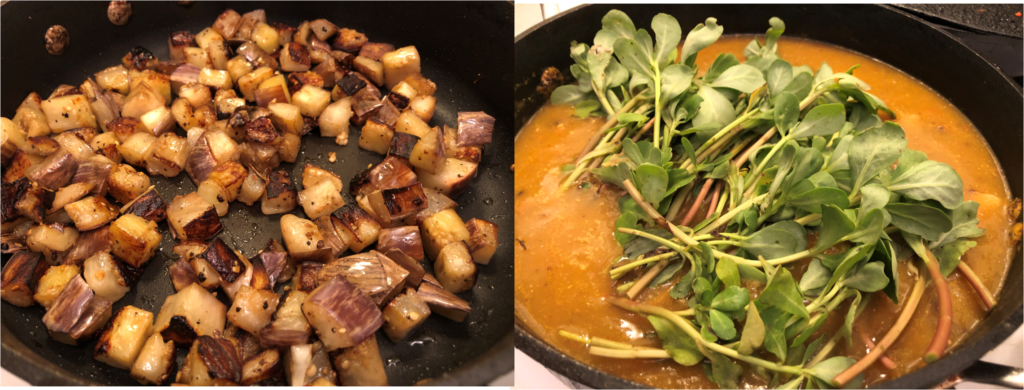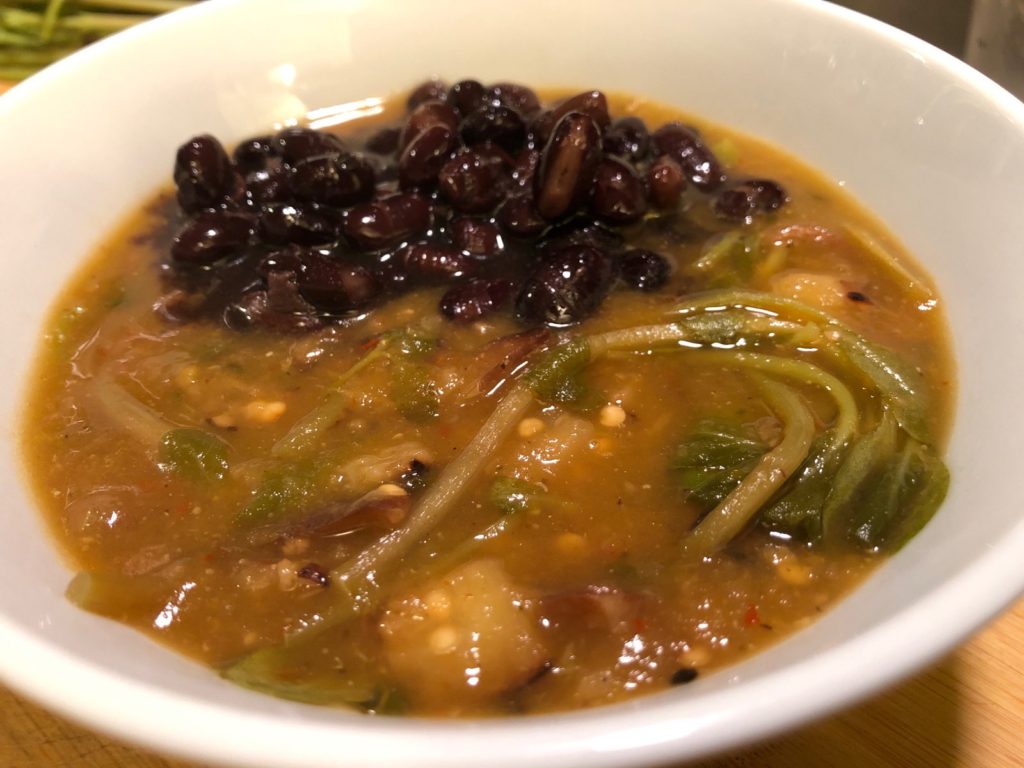
WHAT IS PURSLANE, AND WHY ARE WE GROWING IT?
07/12/19 — Ada Broussard
Some of you may be hip to the power of Purslane, but for those of you who aren’t: this post is for you. Purslane is currently being harvested at JBG, and its appearance in your CSA shares may have some of you scratching your heads. Here at the farm, we intentionally plant and grow this vegetable, but you may have seen purslane growing as a “weed” in your own garden or maybe even even peeking out from sidewalk cracks. This weed-turned-vegetable (dandelion greens’s kindred sister) is resilient and delicious, and we hope you read this post and don’t miss out.
![]() A verdant field of... Purslane. Photo by Scott David Gordon
A verdant field of... Purslane. Photo by Scott David Gordon
As you likely know, so many of the dark leafy greens that dominate ideas of “healthy eating” (spinach, kale, etc.) can’t stand up to this Texas heat and are comically out-of-season in the summer. But here we are, mid-July, and along comes this curious little green, related to succulents, called purslane, pursley, or verdolaga in Spanish. This plant thrives in heat, and is able to offer us something green and leafy in the middle of the summer. That’s vegetable magic, if you ask us! Nestled in these small glossy leaves is a formidable amount of nutritional punch. Purslane contains more Omega-3 fatty acids than many types of fish. I repeat: purslane contains more Omega-3s than many fish and more than any other vegetable, making it a wonderful addition to your diet. This surprising little vegetable is rich in vitamins - most notably Vitamin-A, in addition to Vitamin-C and B. But what does it taste like? Purslane has a slightly lemony flavor and is almost a bit salty, making it a satisfying vegetable eaten both raw and cooked. It’s got a slightly sour-tang, and its texture is like a crunchy-juicy spinach leaf (versus a grassy, dry kale kale leaf). Add it to a salad, throw it in a stew or stir fry, or simply wilt it along with a bit of garlic. Use it as a summery replacement for spinach in a quiche or a sub for parsley in a raw salad.
![]() Bunching purslane for CSA shares and farmers' markets. Photo by Scott David Gordon
Bunching purslane for CSA shares and farmers' markets. Photo by Scott David Gordon
If you’re looking for a direction to turn with this vegetable, there is no better way to wander than to Mexico. Traditional Mexican cooking has made use of this nutritious green for centuries, and though it’s somewhat novel in the modern American diet, farmers’ markets and grocery stores in Mexico stock purslane (verdolaga) as a staple. Before the Rio Grande was considered to be anything more than a mighty river, purslane was part of cooking traditions and indigenous cuisines in many parts of North and Central America.
Not surprisingly, many of the Mexican verdolaga recipes we found online utilized other vegetables currently in season like tomatoes, peppers, and potatoes. Our social media wizard, Hector, is quite the expert on his Mexican foodways, and was kind enough to share two purslane recipes with us. We are sincerely thrilled to share these with you! Hector has worked with JBG since 2010, and has been eating vegetables way longer than that. If you’re looking for no frills internet food inspiration, follow Hector on Instagram to see what he’s cooking. Not only does Hector cook with heart, but he has a familiarity of vegetables and spices that should only belong to a seasoned abuela.
![]() Hector hatching a plan at the farmer's market. Photo by Scott David Gordon
Hector hatching a plan at the farmer's market. Photo by Scott David Gordon
We’re including purslane in at least two of the CSA box sizes next week, likely in the Small and Large boxes. If you’re dying to try some, which we hope you are, shoot Faith an email and we’ll include some in your box if we can! We hope you enjoy these recipes, and get to know this unique, nutritious, and tasty weed...errr, vegetable.
![]()
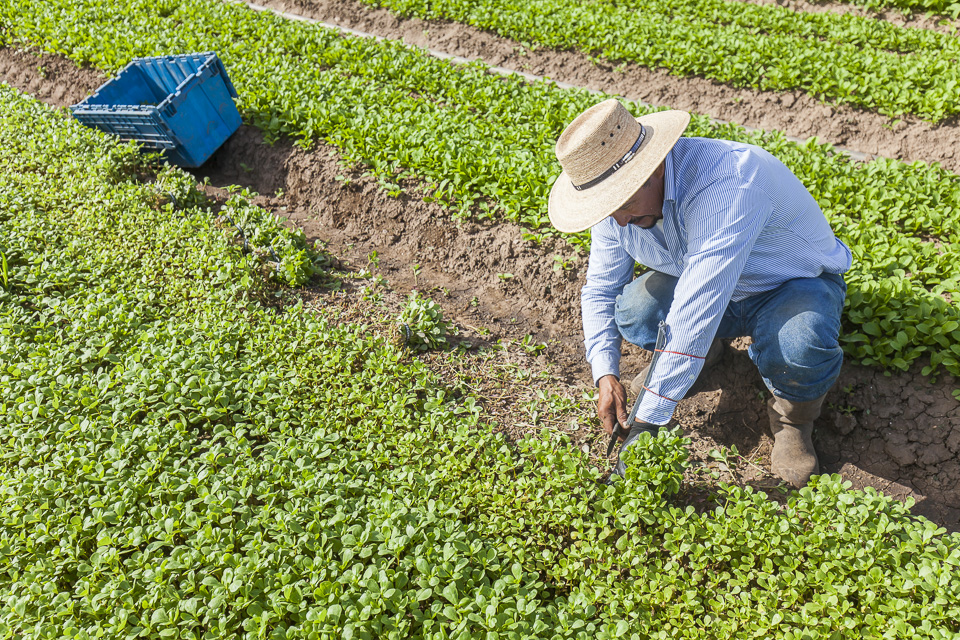 A verdant field of... Purslane. Photo by Scott David Gordon
A verdant field of... Purslane. Photo by Scott David Gordon
As you likely know, so many of the dark leafy greens that dominate ideas of “healthy eating” (spinach, kale, etc.) can’t stand up to this Texas heat and are comically out-of-season in the summer. But here we are, mid-July, and along comes this curious little green, related to succulents, called purslane, pursley, or verdolaga in Spanish. This plant thrives in heat, and is able to offer us something green and leafy in the middle of the summer. That’s vegetable magic, if you ask us! Nestled in these small glossy leaves is a formidable amount of nutritional punch. Purslane contains more Omega-3 fatty acids than many types of fish. I repeat: purslane contains more Omega-3s than many fish and more than any other vegetable, making it a wonderful addition to your diet. This surprising little vegetable is rich in vitamins - most notably Vitamin-A, in addition to Vitamin-C and B. But what does it taste like? Purslane has a slightly lemony flavor and is almost a bit salty, making it a satisfying vegetable eaten both raw and cooked. It’s got a slightly sour-tang, and its texture is like a crunchy-juicy spinach leaf (versus a grassy, dry kale kale leaf). Add it to a salad, throw it in a stew or stir fry, or simply wilt it along with a bit of garlic. Use it as a summery replacement for spinach in a quiche or a sub for parsley in a raw salad.
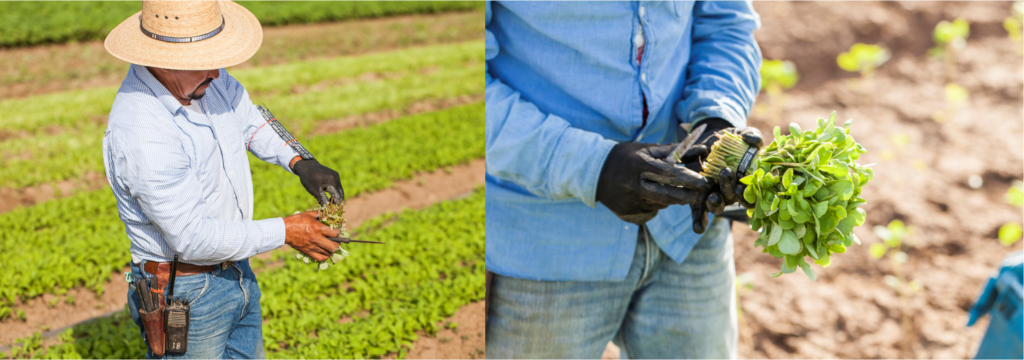 Bunching purslane for CSA shares and farmers' markets. Photo by Scott David Gordon
Bunching purslane for CSA shares and farmers' markets. Photo by Scott David Gordon
If you’re looking for a direction to turn with this vegetable, there is no better way to wander than to Mexico. Traditional Mexican cooking has made use of this nutritious green for centuries, and though it’s somewhat novel in the modern American diet, farmers’ markets and grocery stores in Mexico stock purslane (verdolaga) as a staple. Before the Rio Grande was considered to be anything more than a mighty river, purslane was part of cooking traditions and indigenous cuisines in many parts of North and Central America.
Not surprisingly, many of the Mexican verdolaga recipes we found online utilized other vegetables currently in season like tomatoes, peppers, and potatoes. Our social media wizard, Hector, is quite the expert on his Mexican foodways, and was kind enough to share two purslane recipes with us. We are sincerely thrilled to share these with you! Hector has worked with JBG since 2010, and has been eating vegetables way longer than that. If you’re looking for no frills internet food inspiration, follow Hector on Instagram to see what he’s cooking. Not only does Hector cook with heart, but he has a familiarity of vegetables and spices that should only belong to a seasoned abuela.
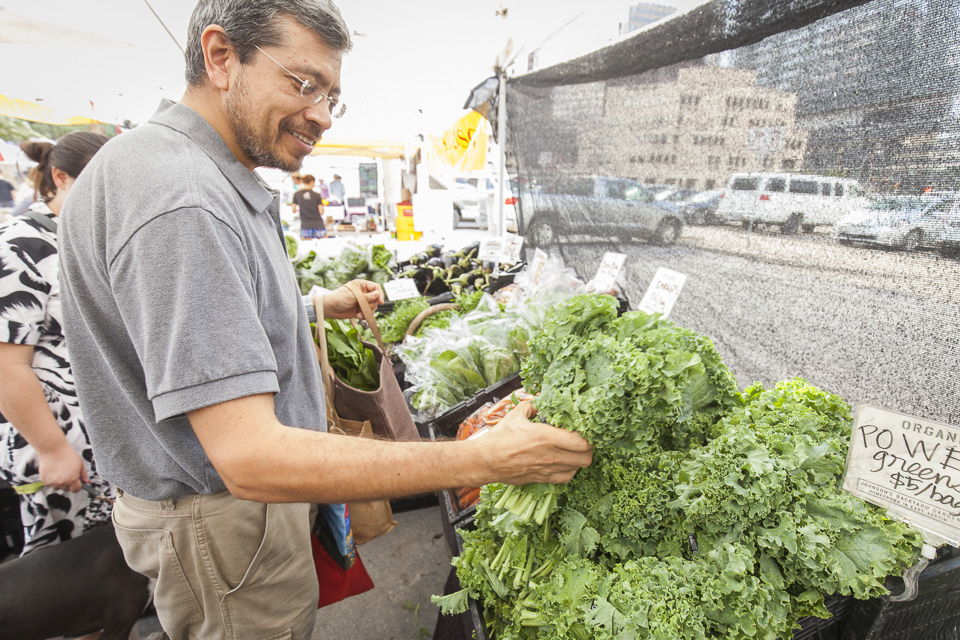 Hector hatching a plan at the farmer's market. Photo by Scott David Gordon
Hector hatching a plan at the farmer's market. Photo by Scott David Gordon
We’re including purslane in at least two of the CSA box sizes next week, likely in the Small and Large boxes. If you’re dying to try some, which we hope you are, shoot Faith an email and we’ll include some in your box if we can! We hope you enjoy these recipes, and get to know this unique, nutritious, and tasty weed...errr, vegetable.
Verdolagas en Salsa / Purslane in Salsa
4 tomatoes, these can be green or red. This is the body for the salsa
1 onion
1 hot pepper. You can add more if you want a spicier dish
1 bunch of purslane/verdolaga
1 eggplant. This is the "meat" for the dish but you can also use other vegetables or proteins, like pork, beef, chicken, or tofu
2 tsp olive oil
Salt and pepper to taste
2 garlic cloves. I ran out of garlic (FOR SHAME) and used garlic powder. Don't tell Doña Licha
Instructions
Put the tomatoes, onion, garlic, and hot pepper in a pot with enough water to cover the ingredients. Set heat to high and reduce to simmer for 15 minutes. The ingredients will be soft then. Remove from the heat and let these rest for 5 minutes.
In the meantime, wash the purslane and cube the eggplant into 1/2 inch pieces.
Heat a large pan to medium high, put the olive oil and sear the eggplant, seasoning with salt and pepper.
Blend the contents of the pot until fully liquid. Pour the salsa into the pan with the eggplant and let is simmer for 10 minutes.
Add the purslane to the pan and stir it into the sauce. Remove from the heat and let it rest for 10 minutes, mixing the ingredients. Serve in a bowl with black beans and yummy tortillas.
Ensalada de Verdolagas / Purslane Salad
2 cucumbers
2 carrots
1 sweet pepper
1 small pint of cherry tomatoes
1 bunch of purslane
2 lemons, juiced
1/4 cup olive oil
1 tbsp sweetener. It could be sugar, honey, agave syrup. This sweetness balances the purslane
Salt and pepper to taste
Instructions
Dice all the cucumbers, carrots, pepper, tomatoes and purslane. Mix in a bowl. Mix the lemon juice, olive oil and sweetener and drizzle the vegetables with it. Add salt and pepper. This is an easy and delicious summer salad.
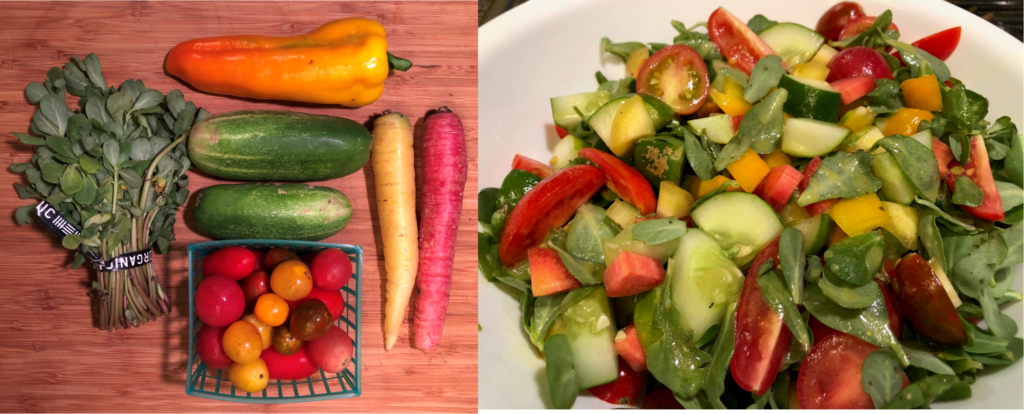






 0 ITEMS IN CART
0 ITEMS IN CART 
